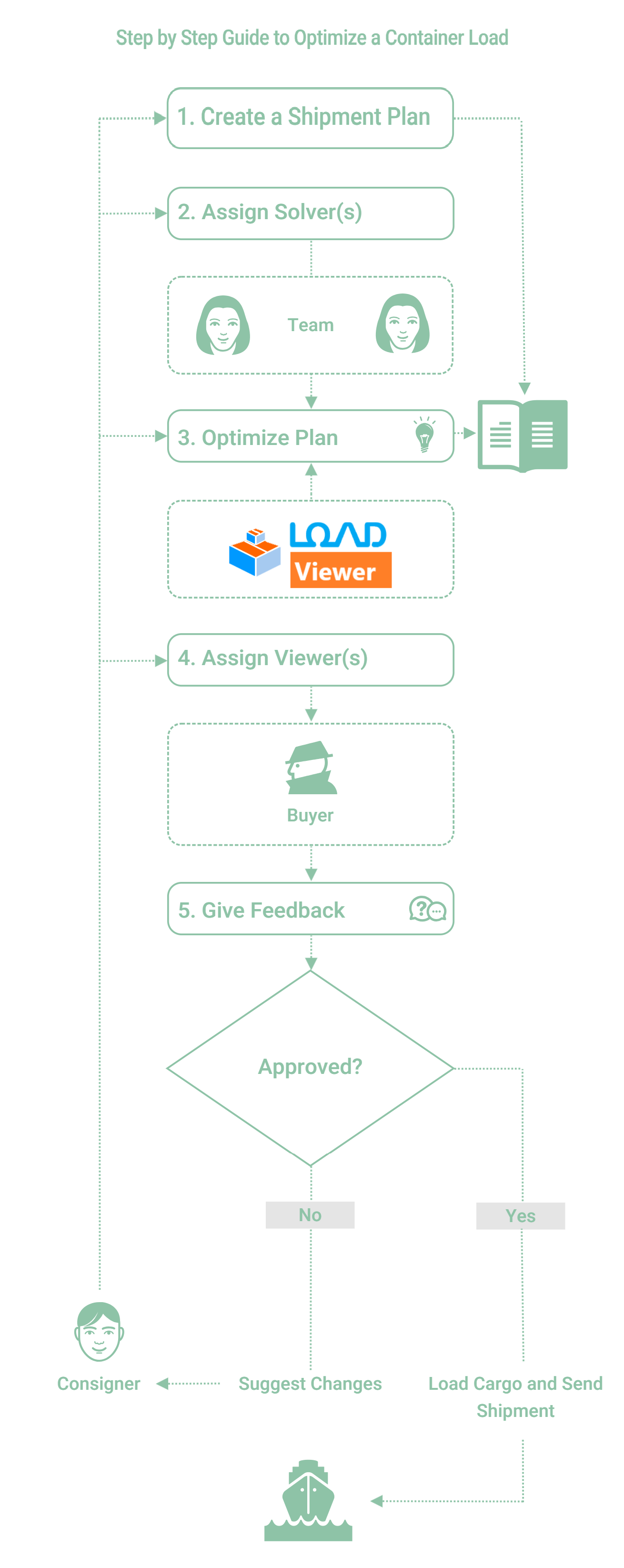Use Case: Efficient Container Load Planning and Approval with LoadViewer
How to effectively utilize LoadViewer's powerful features.
Actors:
- Consignor
- Solvers
- Viewers
Goal:
Optimize container load plans and obtain approval from Viewers for efficient shipment
Preconditions:
- The Consignor, Solvers, and Viewers have access to the LoadViewer platform.
- The necessary shipment details and items are available.
Main Success Scenario:
- The Consignor logs into the LoadViewer platform.
- The Consignor creates a new shipment plan by entering the shipment details, including the destination, container type, weight restrictions, and any specific requirements.
- The Consignor adds the items to be loaded into the shipment plan, specifying the dimensions, weight, and other relevant details for each item.
- Solvers, assigned by the Consignor, access the load plan and provide their solutions or load plans individually.
- Solvers utilize LoadViewer's intelligent algorithm to analyze the shipment details and suggest individual container load plans, maximizing space utilization and considering weight restrictions.
- Solvers work on their respective solutions independently without viewing each other's plans unless granted permission by the Consignor.
- Once the Solvers are satisfied with their solutions, they submit their individual load plans to the LoadViewer platform.
- Viewers, who are the Buyers of the goods being loaded, are granted access to the load plan by the Consignor.
- Viewers review the load plans provided by the Solvers and evaluate them based on efficiency, space utilization, cargo safety, and compliance with their requirements.
- Viewers can download the PDF of their suggested solution from LoadViewer and send it to the Consignor as an agreed-upon solution through official channels if required.
- Viewers can provide feedback or suggestions for modifications to the Consignor, who can then communicate the changes to the Solvers for further adjustments.
- Solvers revise their respective load plans based on the feedback provided by the Viewers or Consignor.
- The iterative process continues until the Viewers are satisfied with a particular load plan or a consensus is reached.
- Once the Viewers approve a load plan, the Consignor finalizes it and proceeds with executing the shipment according to the agreed-upon plan.
- Throughout the shipment process, the Consignor can track the progress, communicate any updates or changes to the stakeholders, and ensure that the executed plan aligns with the approved load plan.
Alternate Paths:
- If the suggested load plans by the Solvers do not meet the Consignor's or Viewers' requirements, the Consignor can request modifications and provide feedback to the Solvers for adjustments.
- If there are changes in the shipment details or items, the Consignor can update the load plan accordingly and seek approval from the Viewers.
- If additional stakeholders need access to the load plan, such as shipping agents or warehouse personnel, the Consignor can assign appropriate permissions within the LoadViewer platform.
- If any issues or questions arise during the planning process, the stakeholders can seek assistance from the LoadViewer support team.
Postconditions:
- The load plan is optimized, approved by the Viewers, and finalized by the Consignor, ensuring efficient space utilization and compliance with the requirements.
- The shipment is executed according to the agreed-upon load plan, minimizing logistics costs and avoiding penalties.
- All stakeholders have access to the necessary load plan information, facilitating effective collaboration and communication.
This use case reflects the specific roles and permissions within the LoadViewer system, highlighting the workflow involving the Consignor, Solvers, and Viewers to optimize container load plans and obtain approval for efficient shipments.
